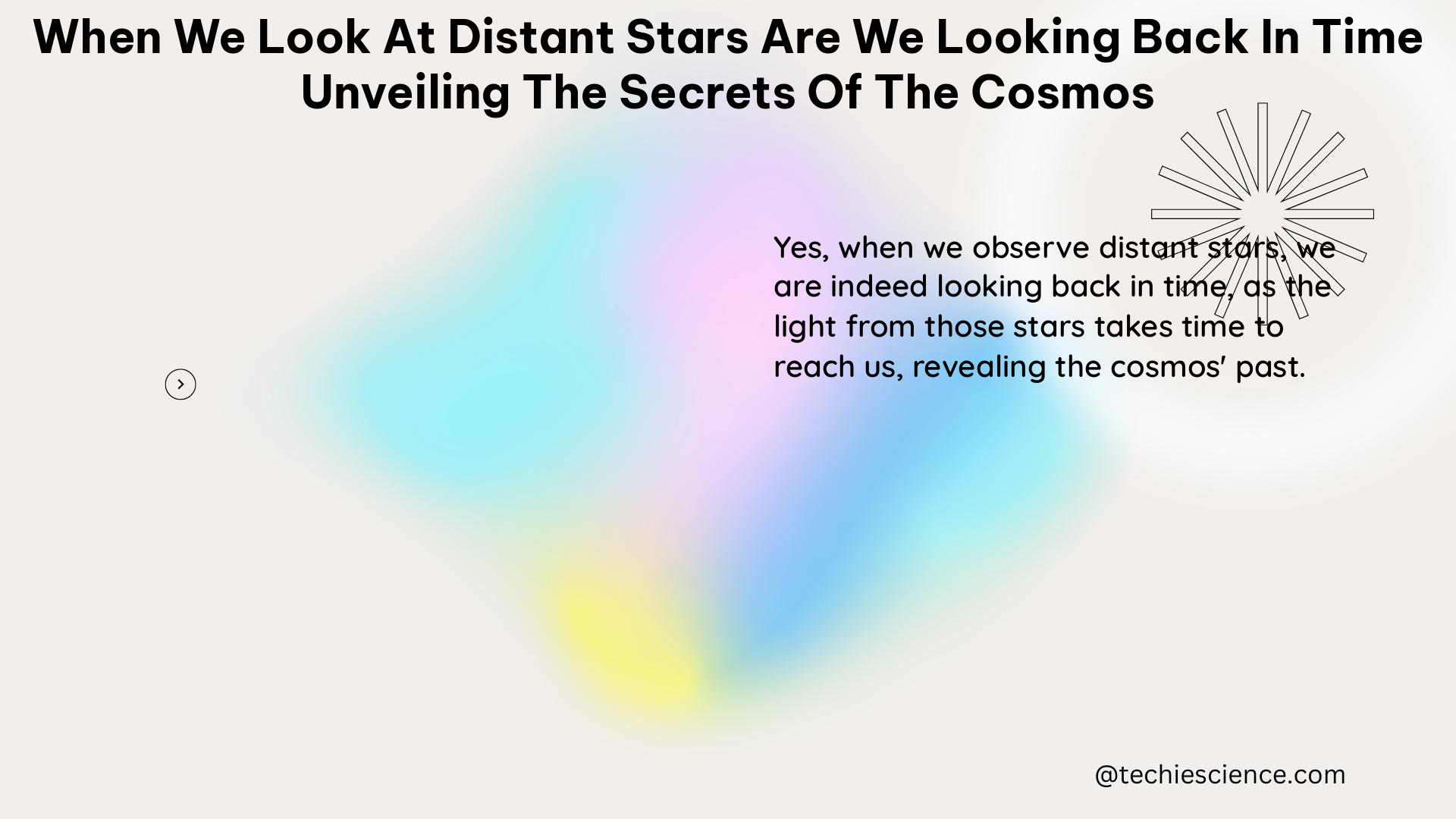When we gaze up at the night sky, we are not just admiring the twinkling stars, but we are also peering into the past, unveiling the secrets of the cosmos. The light from distant stars takes time to reach our eyes, and by understanding this phenomenon, we can unravel the mysteries of the universe.
The Concept of Parallax: Measuring Stellar Distances
The key to understanding how we can look back in time when observing distant stars lies in the concept of parallax. Parallax is the apparent shift in the position of an object relative to the background when viewed from different positions. This principle can be used to measure the distance to nearby stars.
Trigonometric Parallax
The trigonometric parallax method involves measuring the position of a star from two points on opposite sides of Earth’s orbit, six months apart. This small angular displacement relative to background stars can be used to calculate the distance to the star.
The formula for calculating the distance to a star using parallax is:
Distance (in parsecs) = 1 / Parallax (in arcseconds)
Where:
– 1 parsec (pc) = 3.26 light-years (ly)
– If the parallax (p) is 1 arcsecond (1″), the distance is 3.26 light-years.
For example, the nearest star to Earth, Proxima Centauri, has a parallax of 0.76813″, meaning its distance is 1.302 parsecs or 4.24 light-years. The parallax of Barnard’s star, the next closest after the Alpha Centauri system, is 0.54831″, indicating a distance of nearly 6 light-years.
Limitations of the Parallax Method
The parallax method is only useful for nearby stars within a few thousand light-years. For more distant stars, indirect methods are used to estimate their distances.
Indirect Methods for Measuring Stellar Distances

When the parallax method becomes impractical for distant stars, astronomers employ indirect methods to estimate their distances.
Spectroscopic Parallax
This method involves comparing the intrinsic brightness of a star (found from its spectrum or other observable properties) with its apparent brightness. By knowing the star’s absolute magnitude (the brightness it would have if it were 10 parsecs away) and its apparent magnitude (the brightness we observe), the distance to the star can be calculated using the inverse-square law:
Distance (in parsecs) = 10^((Absolute Magnitude - Apparent Magnitude) / 5)
This method allows astronomers to estimate the distance to other stars with the same color but different brightness.
Cepheid Variable Stars
Cepheid variable stars are a type of pulsating variable star that have a well-established relationship between their luminosity and the period of their brightness variations. By measuring the period of a Cepheid variable star and using this relationship, astronomers can determine its absolute magnitude and, in turn, its distance.
Supernovae
Supernovae, the explosive deaths of massive stars, can be used as standard candles to measure cosmic distances. Type Ia supernovae, in particular, have a well-defined peak luminosity that can be used to determine their distance from Earth.
The Implications of Observing Distant Stars
When we observe distant stars, we are not just seeing them as they are now, but as they were in the past. The farther the star, the longer the light has taken to reach us, and the more we are seeing into the past.
Time Travel through Light
The speed of light is finite, approximately 299,792 kilometers per second (186,282 miles per second) in a vacuum. This means that the light from distant stars takes time to reach us, and we are effectively looking back in time when we observe them.
For example, the light from the Andromeda Galaxy, the nearest major galaxy to the Milky Way, takes about 2.5 million years to reach us. This means that when we look at the Andromeda Galaxy, we are seeing it as it was 2.5 million years ago, not as it is now.
Unveiling the Secrets of the Cosmos
By observing distant stars and understanding the time it takes for their light to reach us, we can unravel the secrets of the cosmos. We can study the evolution of stars, the formation of galaxies, and the large-scale structure of the universe, all by peering into the past.
Furthermore, the study of distant stars and their properties can provide insights into the early stages of the universe, the formation of elements, and the nature of dark matter and dark energy, which are fundamental to our understanding of the cosmos.
Conclusion
When we gaze up at the night sky and observe distant stars, we are not just admiring their beauty, but we are also traveling back in time, unveiling the secrets of the cosmos. By understanding the principles of parallax and other indirect methods of measuring stellar distances, we can piece together the history and evolution of the universe, one star at a time.
References:
– Parallax and Stellar Distances
– Distances to the Stars
– How Do We Know How Long Light Has Been Traveling?
– Inverse-Square Law
– Cepheid Variable Stars
– Type Ia Supernovae as Standard Candles

The lambdageeks.com Core SME Team is a group of experienced subject matter experts from diverse scientific and technical fields including Physics, Chemistry, Technology,Electronics & Electrical Engineering, Automotive, Mechanical Engineering. Our team collaborates to create high-quality, well-researched articles on a wide range of science and technology topics for the lambdageeks.com website.
All Our Senior SME are having more than 7 Years of experience in the respective fields . They are either Working Industry Professionals or assocaited With different Universities. Refer Our Authors Page to get to know About our Core SMEs.